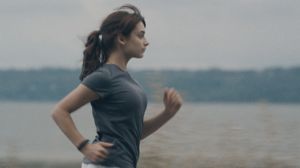I have a theory. It has to do with what makes a film worthy of playing at the Cannes Film Festival.
Obviously, films selected at Cannes always reflect a unique take on a theme or idea. The French, after all, were the first to fully embrace auteur theory, and have always been eager to worship the work of a cinematic auteur. But it's more than that.
I believe that all submissions to the festival are run through a computer algorithm that measures the consistency of the film's art direction. If a rogue colour or flagrant shape invades the frame and contradicts the movie's palette (established in the first few scenes), you can forget it. On both these fronts, Sarah Prefers to Run is worthy of being shown on the world's most prestigious screens. Even if the film lack some of the simpler, emotional elements often craved by mainstream audiences.
The auteur who guides your art direction in Sarah Prefers to Run is writer/director Chloe Robichaud, who, at age 25, is just a few years older than her protagonist Sarah (Sophie Desmarais). This gives the story a rare sense of authenticity, portraying the confusion of youth without the nostalgic hue of hindsight to soften the blow. In fact, the hue here is almost completely grey and white. From the props, to the sets, to the clothing on the extras--nothing strays too far from a subdued, colourless vision of a girl painfully trying to discover herself. Even those orange pylons are white in the film - it's a nice touch.
This pared-down approach is both the film's biggest strength and its biggest commercial liability. Sarah is a simple girl. Frustratingly simple, at times. As the title suggests - and as the character states rather perfunctory whenever questioned - she simply likes to run. Sarah and Forrest Gump would probably make fast friends (but the conversations wouldn't get very far). Those walls you choose to leave blank often mirror the glazed expression on Sarah's face.
Sarah is conflicted. Moving from Northern Quebec to Montreal with her platonic friend Antoine (Jean-Sebastien Courchesne), she attends university on a running scholarship but has no ambitions beyond circling the track. Her inability to see the big picture also makes her decision to marry Antonie - simply to be eligible for a special grant - more believable. The fact she wears a black wedding dress to the ceremony is worth noting. It becomes clear, however, that Antoine's feelings are growing within this relationship of convenience, while Sarah is simply drifting through university (and beginning to notice the other girls in the shower). At this point, hints of primary color emerge, but never in a manner that calls attention. After all, as Robert McKee says, if the hidden symbols in a film's art direction draw attention to themselves, they are rendered powerless. But I think the fact that I was drawn consciously to your work is a compliment. It did, after all, do a lot of the emotional heavy-lifting--and, of course, got the film through that secret Cannes art-direction algorithm.
Sincerely,

Christopher







